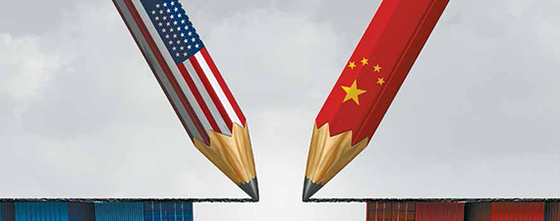Enhancing relations with India

Shin Bong-kil
The author, a former Ambassador to India, is a chair professor at the University of North Korean Studies in Seoul.
In September 2019, I met then-U.S. Ambassador to Korea Harry Harris for the first time on a boat off the charming coast of the Maldives, an archipelagic country about 750 kilometers (470 miles) to the southwest of India. At that time, we were both attending the fourth Indian Ocean Conference hosted by the India Foundation and the Foreign Service Institute of the Maldives a few months before the Covid-19 pandemic hit Korea. The conference is an annual international forum organized by India since 2016 to cope with China’s 21st Century Maritime Silk Road initiative.
On the way to the Maldives, I stopped over in Sri Lanka. Everywhere in the island nation, I could feel the power of China. Pointing at dazzling skyscrapers rising along the coast of Colombo, a staffer from the Korean Embassy in the capital city said, “The influx of Chinese capital is building a huge financial town on the coast by reclaiming land from the sea. China plans to transform the city into another Hong Kong.”
China is developing Hambantota Port after obtaining the rights to operate it for 99 years. High-rise hotels also were being built along the coastline densely packed with seashore villas. A representative of Oman attending the conference tipped me off. “In Oman, the Chinese are building a mineral water bottling factory,” he said.
Who is threatening who?
In the first session of the conference on Sept. 3-4, Harris talked about the Indo-Pacific strategy of the United States — not as U.S. Ambassador to Seoul but as former commander of the U.S. Indo-Pacific Command. “China’s bullying in the South China Sea reflects a broader choice for nations in the region: coercion and control, or freedom and the rule of law,” he said. “The One Belt, One Road initiative ignores international norms on transparency and entices countries into a debt trap that leaves them vulnerable to coercion and threatens their sovereignty.”
After Harris finished his speech, an enraged Chinese representative retorted, “China certainly has jurisdictions over the South China Sea. Who’s bullying who, anyway?” His rough rhetoric reflecting China’s “Wolf Warrior” diplomacy seemed to make the U.S. ambassador on the podium perplexed.
Amb. Harris was in a bad mood before leaving Seoul after being summoned by the Ministry of Foreign Affairs over his straightforward remarks about the General Security of Military Agreement (Gsomia) between Korea and Japan. He thought he was disgraced by the foreign ministry’s media play.
Harris came to the Maldives after canceling all events in Seoul. Without hiding uncomfortable feelings, he repeatedly expressed his disappointments at the ministry. Bitter was the scene of America engaging in a war of words with China at an international convocation — and of the U.S. keeping uneasy relations with its decades-old ally.

China rebounds
In early 2018, a Korean corporate leader visited New Delhi to participate in the Korea-India Business summit and asked me point-blank if a war will break out between America and China. At the time, Harvard University Professor Graham Allison’s book “Destined for War” had big repercussions, as it employed the lens of Thucycides’s Trap — a deadly pattern of structural stress that results when a rising power challenges a ruling one — to explain the deepening U.S.-China contest.
A hegemon refers to a state or group dominating others with its overwhelming military and economic power. Since Xi Jinping’s election as China’s president, Beijing has championed the revival of Chinese people by achieving the “Chinese Dream.” After enduring a century of humiliation since the fall of the Qing dynasty, China dumped Deng Xiaoping’s mantra — “Hide your brightness, bide your time” — and embarked on an aggressive external expansion with the Belt and Road Initiative.
To America did China send the message of coexistence and compromise based on the New Great Power Relations and the Community of Common Destiny for Mankind. Such logic somehow worked until Barack Obama’s administration. But it was a different story after Donald Trump took power in January 2017. The U.S. could not dismiss China’s dramatic rise threatening U.S. hegemony. Trump’s strategists attributed America’s decline to China’s unfair practices in various fields. The results are the ongoing trade and technology wars in Joe Biden’s administration.
Prudence needed to join QUAD
The United States started keeping China in check from 2017 to ensure a “Free and Open Indo-Pacific.” It persuaded old allies Japan and Australia — and India this time — to launch the Quadrilateral Security Dialogue (QUAD). In March 2021, the first QUAD summit was held, albeit virtually, in the face the Covid-19 pandemic. A serious border clash between India and China on the Himalayas the previous year may have played a part in India’s participation in the security dialogue.
In the QUAD summit last year, the four members released a joint statement affirming their agreement to set up three working groups: on vaccines, climate change and emerging core technologies. The statement did not include any strategy to contain China. But Beijing is wary of the possibility of the security paradigm serving as a steppingstone for the U.S. to form a NATO-like alliance in the Indo-Pacific. Some pundits in Korea rushed to talk about the need to join the QUAD. But given Korea’s geopolitical differences from the four countries, it is too early to talk about joining the quadrilateral dialogue.
The Myeong-dong streets I strolled along at yearend after returning home in July from India were chilly. They were supposed to be bustling with Chinese and Japanese tourists. The remarkable turnaround obviously owed much to the pandemic, but it seemed to show the current condition of Korea’s relations with China and Japan. The most urgent task for Korea’s diplomacy is to normalize its relations with the two neighbors.
Chinese Ambassador to Seoul Xing Haiming, a long acquaintance I met at the Chinese Embassy in Myeong-dong, deemed the discord over the Thaad missile defense system and the Sino-U.S. rivalry major sources of conflict.
Learning from India and China
U.S.-China conflict is certainly a conundrum for Korea’s diplomacy. But considering complicated factors Korea must weigh carefully, it is shortsighted to rush to take one’s side. There is no better solution than dealing with China on an agenda basis to protect Korea’s national interest as we did in the past — for instance, Korea’s joining the China-led Asian Infrastructure Investment Bank (AIIB) and deploying the Thaad system. The same standards must apply to Korea’s participation in the upcoming Beijing Winter Olympics and America’s Indo-Pacific strategy, too. In the process, Korea must be able to say “No” to others, including the U.S. and China, if the need arises.
Over the diehard legacy of Japan’s wartime forced labor and sexual slavery, the time has come for Korea to address them on its own. The government must not adhere to its demand for apology and compensations from Japan. Despite the British rule for more than two centuries, India has never demanded reparations. The issue was first raised — and humorously — by Indian lawmaker Shashi Tharoor, who proposed in his speech at the Oxford Union that the UK pay one British pound per annum for the next two centuries as a form of symbolic reparations for “200 years of Britain in India.” China, too, suffered enormous damages from imperial Japan’s aggression, but refused war reparations from Tokyo in the 1972 Joint Communiqué. Beijing’s decision reflected the delicate situation China faced at the time, yet it stopped short of forcing Tokyo to pay the painful war reparations China experienced before. It is the time for Korea to solve the problem on its own.
Late Kim Young-hie’s proposal
Another issue Korean diplomacy must tackle in the Indo-Pacific era is epochal reinforcement of its relations with India. Fortunately, the Moon Jae-in administration took a strategic approach to the subcontinent in its New Southern Policy, considering that India’s GDP will be the third largest following the U.S. and China in 2030.
Standing on the watchtower of the Red Fort in Old Delhi — a magnificent fortress-palace built by Mughal Emperor Shah Jahan in the 17th century — on India’s 72nd Independence Day on August 15, 2018, Prime Minister Narendra Modi made an emotional 80-munite-long speech pleading for change. “Today the world says the ‘sleeping elephant’ has started walking,” he said. “[But] I am impatient because many countries are ahead of us, I am impatient to take our country ahead of all of them.”
India, a pivotal member of the QUAD, is important to Korea in security strategy terms as well. Korea has no historical debt with India, a military power with two aircraft carriers, except for the love story — and marriage — of King Kim Suro, the legendary founder of Geumgwan Gaya (AD 43 to 532) in Korea, and a princess from the Ayuta Kingdom in India — about two millenniums ago.
Korea must strengthen strategic cooperation with India beyond the limits. In his last column before passing away in January 2020, the legendary journalist Kim Young-hie of the JoongAng Ilbo highlighted the importance of reinforcing the staff at the Korean Embassy in New Delhi to a “reckless” level if Korea really wants to cope with a plethora of new challenges in the Indo-Pacific era. His wisdom still reverberates.
Translation by the Korea JoongAng Daily staff.










with the Korea JoongAng Daily
To write comments, please log in to one of the accounts.
Standards Board Policy (0/250자)